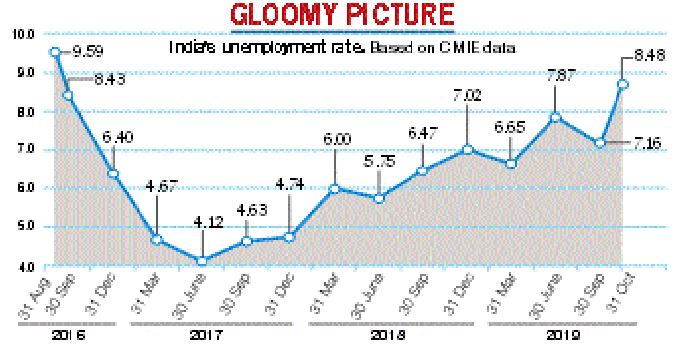The gloom and doom scenario in India’s economy darkened a little more on Friday after an independent database company threw up an alarming statistic: the unemployment rate in October had surged to 8.48 per cent — the highest since August 2016.
The Centre for Monitoring Indian Economy (CMIE) — a respected private researcher — said the unemployment rate in urban India was 8.89 per cent and in the rural sector, 8.28 per cent.
The overall unemployment rate in the previous month was 7.16 per cent. In August 2016, the jobless rate stood at 9.59 per cent.
The surge in the unemployment rate is a reflection of the grinding slowdown in the Indian economy that began last year with a contraction in consumption, drop in private capital expenditure and the snowballing crisis in the shadow banking sector.
The Narendra Modi government hastily cobbled up a set of economic measures that included a cut in the corporate tax rate while the Reserve Bank of India trimmed interest rates five times this year. None of this has arrested the slide.
The higher unemployment rate will have implications for the aggregate demand in the economy.
On Friday, another private survey — the Nikkei Manufacturing Purchasing Managers’ Index, compiled by IHS Markit — showed that growth in factory activity had tumbled to a two-year low in October, dragging business confidence down to its weakest since 2017.
The index sank to 50.6
in October from 51.4 the previous month — barely above the 50-point threshold that separates growth from contraction.
“PMI data for October showed a continuation of manufacturing sector weakness in India with sales growth softening to the slowest in two years,” said Pollyanna De Lima, principal economist at IHS Markit.
“Weakening demand had a domino effect in the manufacturing industry, knocking down rates of increase in production, employment and business sentiment.”
The new orders sub-index, a proxy for domestic demand, slumped to 51.3 from September’s 52.3, its lowest since October 2017. That pushed firms to slow the pace of hiring to a six-month low, which is likely to raise concerns for Narendra Modi’s government given it is under pressure to create more jobs.

Ready to work but….
The CMIE computes the unemployment rate on the basis of a household survey of people not employed but willing to work and actively looking for a job as a percentage of the total labour force.
The total labour force is the sum of those who are employed and those who are unemployed but are willing and looking for a job.
According to the CMIE website, it directly interviews a large sample of randomly selected households to find the employment status of all members aged over 15. The sample households are drawn from a panel of households included in its “consumer pyramids survey”. This panel contains over 174,405 households, which include over 522,000 members who are over 15 years old.
While the full sample of 174,405 households is surveyed over a four-month period, the sample size of 43,600 households per month is well distributed over the country to enable the estimation of a monthly unemployment rate.
The numbers released by the agency for May-August 2019 showed that nearly 40.49 crore people were employed in the country.
Back in May, the ministry of statistics and programme implementation had released the report of the National Sample Survey Office, which showed that the unemployment rate in India had touched 6.1 per cent -– a 45-year high.
The report was ready for release in December 2018 but the Modi government deliberately refused to make it public, afraid that it could wreck its chances in the April-May 2019 general election.
While releasing the report later, the finance ministry issued a statement claiming the figure could not be compared with past data.
The Periodic Labour Force Survey had pegged the unemployment rate in urban areas at 7.8 per cent and that in rural areas at 5.3 per cent.
Three members of the National Statistics Commission resigned in January this year in protest against the government’s decision to withhold the release of the NSSO’s first annual survey on employment and unemployment for 2017-18.
The difference between the CMIE and NSSO figures is a result of differing sampling methods.
The RBI had recently said in its monetary policy report that the private corporate sector had not been adding new capacities while its existing capacity utilisation had risen close to its long-term average for several quarters.
However, it had expressed hope that the measures announced by the Centre would help kick-start the investment cycle so that new production capacities would come on stream and lead to the strengthening of domestic demand in the short term while boosting the medium-term growth potential of the economy.










